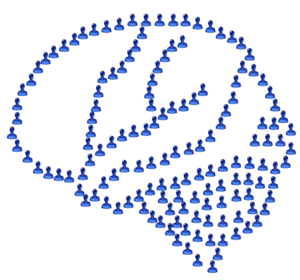China brain

In the philosophy of mind, the China brain thought experiment (also known as the Chinese Nation or Chinese Gym) considers what would happen if each member of the Chinese nation were asked to simulate the action of one neuron in the brain, using telephones or walkie-talkies to simulate the axons and dendrites that connect neurons. Would this arrangement have a mind or consciousness in the same way that brains do?
Early versions of this argument were put forward in 1974 by Lawrence Davis[1] and again in 1978 by Ned Block.[2] Block argues that the China brain would not have a mind, whereas Daniel Dennett argues that it would.[3]
It is not to be confused with the Chinese room argument proposed by John Searle,[4] which is also a thought experiment in philosophy of mind but relating to artificial intelligence.
Background
Many theories of mental states are materialist. That is, they describe the mind as the behavior of a physical object like the brain. One formerly prominent example is the identity theory, which says that mental states are brain states. One criticism is the problem of multiple realizability. The physicalist theory that responds to this is functionalism, which states that a mental state can be whatever functions as a mental state. That is, the mind can be composed of neurons, or it could be composed of wood, as long as it provides mental functionality.
The thought experiment
Suppose that the whole nation of China was reordered to simulate the workings of a single brain (that is, to act as a mind according to functionalism). Each Chinese person acts as (say) a neuron, and communicates by special two-way radio in the corresponding way to the other people. The current mental state of China brain is displayed on satellites that may be seen from anywhere in China. China brain would then be connected via radio to a body, one that provides the sensory inputs and behavioral outputs of China brain.
Thus China brain possesses all the elements of a functional description of mind: sensory inputs, behavioral outputs, and internal mental states causally connected to other mental states. If the nation of China can be made to act in this way, then, according to functionalism, this system would have a mind. Block's goal is to show how unintuitive it is to think that such an arrangement could create a mind capable of thoughts and feelings.
Consciousness
The China brain argues that consciousness is a problem for functionalism. Block's Chinese nation presents a version of what is known as the absent qualia objection to functionalism because it purports to show that it's possible for something to be functionally equivalent to a human being and yet have no conscious experience. A creature that functions like a human being but doesn't feel anything is known as a "philosophical zombie". So the absent qualia objection to functionalism could also be called the "zombie objection".
Criticisms
Some philosophers, like Daniel Dennett, have concluded that the China brain does create a mental state.[3] Functionalist philosophers of mind endorse the idea that something like the China brain can realise a mind, and that neurons are, in principle, not the only material that can create a mental state.[5]
See also
- Blockhead (computer system)
- Alan Turing
- Behaviorism
- David Chalmers
- Dualism
- Eliminative materialism
- Hilary Putnam
- Neutral monism
- Orchestrated objective reduction
- Property dualism
- Systems theory
References
- ↑ David Cole (2009). "Section 2.3 The Chinese Nation". The Chinese Room Argument. Stanford Encyclopedia of Philosophy.
- ↑ Ned Block (1978). "Troubles with functionalism". Minnesota Studies in The Philosophy of Science 9: 261–325.
- 1 2 Daniel Dennett (1991). "Chapter 14. Consciousness Imagined". Consciousness Explained. Back Bay Books. pp. 431–455.
- ↑ John R. Searle (1980). "Minds, brains, and programs". Behavioral and Brain Sciences 3 (3): 417–457. doi:10.1017/S0140525X00005756.
- ↑ Edward Feser (2006). "The "Chinese nation" argument". Philosophy of Mind: A Beginner’s Guide. Oxford: Oneworld. pp. 89–93.